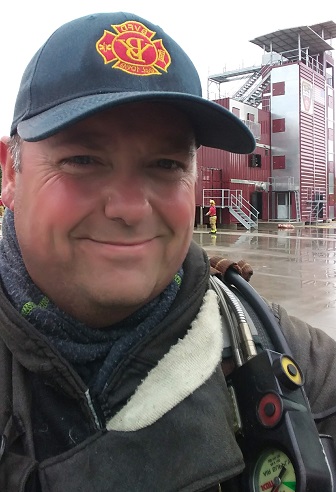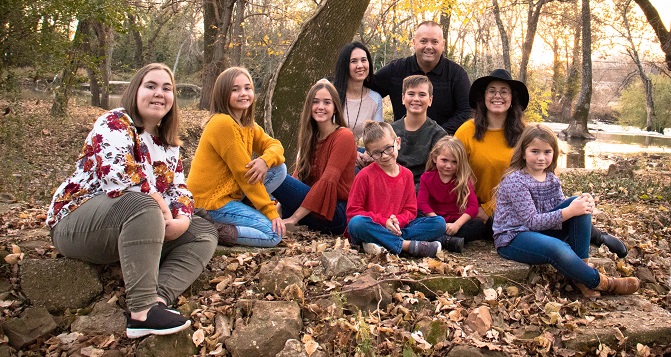Chief Scott Cranford Survives Widow-maker Heart Attack; Uses Experience to Help Others
2/5/2020
Every minute matters in a heart attack
 As division chief for the City of Bella Vista Fire Department, Scott Cranford plays a vital role in training and supervising first responders whose job it is to save lives. But it was he himself in need of rescue on October 21 when he had a major heart attack at work.
As division chief for the City of Bella Vista Fire Department, Scott Cranford plays a vital role in training and supervising first responders whose job it is to save lives. But it was he himself in need of rescue on October 21 when he had a major heart attack at work.
Husband to Jessica and father of eight children ages 4 to 21, Cranford, 45, had never had any heart problems. He works out, officiates sports and doesn’t drink or smoke. In fact, he’d even lost about 50 pounds in the past two years. He describes himself as “always working… that’s my lifestyle.”
Cranford’s day had begun with a large, mass-casualty training exercise which was quickly followed by a real emergency. A bus wreck on Highway 49 caused a fire which threatened to ignite two large propane tanks. Cranford and his team from the Bella Vista Fire Department were called in as mutual aid to provide immediate assistance to the White Rock Fire Protection District.
“We found a large propane tank spewing active fire, and several pipelines that appeared to be damaged and ripped from in and around the two large tanks; one estimated at 30,000 gallons in size; the other 20,000 gallons…it was unknown what amount was actually in both tanks”, said Cranford.
By consensus of Incident Command on scene, actions required Cranford to step into the role of firefighter, knowing at any moment a life-threatening explosion could occur. People were being evacuated within a mile of the incident in all directions.
“There was a lot of strain and stress as well as physical exertion,” he recalls.
In hindsight, he noticed his first symptoms at the scene.
“I started feeling nauseous at the scene, but it went away. Then when we got back to the station, I felt general malaise (discomfort or uneasiness). Then I got pale and diaphoretic (sweaty)... I was cold and couldn’t seem to get warm. It felt like I'd sucked in 15 minutes of cold air. I sat in a chair inside the fire station to recover and – even though I knew the symptoms of a heart attack – I was experiencing every bit of denial.”
That’s when his co-workers – fellow firefighter/paramedics – noticed.
“They said: Scott, you don't look so good... let us hook you up to the EKG monitor.”
When the EKG monitor was first applied to Cranford, no symptoms of heart attack was detected. But because medics use a concept called "Treat the patient; not the monitor,” they kept watching the chief because of his symptoms.
“I told them to let me just sit down and rest for a few, and then I became nauseated and went to the restroom, not realizing – in hindsight – that my body was dying as a big portion of my heart was being deprived of oxygen. While in the restroom, Station 1 crews were called out to a reported structure fire and so all of the crews left the station immediately. I remember thinking, 'Oh God, I’m going to die on the toilet.' So I cleaned myself up quickly and went out into the hallway and towards the front offices where I knew the administrative assistant and billing clerk assistant were located and called for help. They asked what was going on and I explained, 'I don’t feel good, something’s wrong; I need an ambulance back here quick.' Thank goodness that the fire call turned out to be no fire therefore allowing crews to respond back immediately. When they rushed into the station, paramedic Leon Lieutard immediately hooked me up to the 12-lead EKG which showed anterior wall left myocardial infarction involving left anterior descending (LAD) artery blockage. That’s called the ‘widow-maker’ because it kills so many people.”
A widow-maker is one of the deadliest kinds of heart attacks, responsible for as many as one-third of sudden cardiac deaths in the U.S. This vessel provides blood and oxygen to the entire front of the heart (about 40 percent of the heart’s blood supply and a significantly larger area than other coronary arteries supply.
While some of the next steps are fuzzy, Cranford recalls being loaded into an ambulance even as his co-worker, Paramedic Lieutard, was calling Northwest Medical Center-Bentonville. Thanks to the newest protocols, first responders now identify heart attacks in the field and alert the hospital staff en route to activate the cardiac catheterization lab in order to have the staff ready as soon as the ambulance pulls in. This enables the patient to skip the emergency department altogether and get straight to cardiac catheterization laboratory for life-saving treatment faster.
Every minute counts in a heart attack. The longer the artery is blocked, the greater the potential for death or permanent injury or disability.
In Cranford’s case, the steps his co-workers took likely saved his life.
He remembers the phone call by Paramedic Lieutard, (“we’re coming in with one of our own”), many nurses, doctors and “Big Wigs” being there, and other hospital staff “lined up left and right” as he was wheeled through the doors of the ER. He even remembers being rolled straight into the cath lab from ambulance and commenting on the monitors. But then his heart stopped.
CPR was performed and defibrillator was used to shock his heart twice.
“I woke up to a nurse who was saying ‘Honey, just stay with me.’ I felt good, and had no soreness.”
Interventional cardiologist Dr. Pahul Singh performed cardiac catheterization emergently which showed proximal LAD occlusion (blockage) and implanted a 3.5mm stent to open the artery.
Cranford’s “door-to-balloon time” – even with CPR and defibrillation – was an amazing 25 minutes.
What did Cranford take away from this experience that will help others?
“If this had happened after work – or if I had gone anywhere else - who knows what my prognosis would have been?”
“I did not have any chest pain. The reality is that no one knows what a first-time heart attack or stroke is going to feel like to them. For me, it kind of felt like the flu was coming on, but I didn't buy into that because no one had the flu in the fire department. As a paramedic by trade, I know we try to diagnose ourselves. But what I would tell the average person is that there's no way to know what signs and symptoms of a first-time event are going to feel like, to you specifically. We are each different, and we can be our own worst enemy (by denying that our symptoms could be serious).”
“As soon as you put together any of the signs and symptoms, you need to recognize what could be happening and call for help immediately. The speed with which you get to definitive care can be a matter of life or death,” Cranford said. “In the case of a heart attack, for me, getting definitive care was not seeing a paramedic or going to an urgent care center or even an ER but going straight from the ambulance into a cath lab where they could open the blocked vessel.”
“People have to recognize when something's not right; something could mean everything.”
Dr. Singh adds: “Stay calm and call for help right away if you experience any signs or symptoms of heart attack including chest pain, shortness of breath, jaw pain or profuse sweating since EVERY MINUTE COUNTS”.
Why minutes matter
Door-to-balloon time – or definitive treatment to unblock an artery – has been set as a core quality measure for hospitals who are accredited by The Joint Commission. Thanks to the work of hospitals and care providers nationwide, a patient experiencing an ST-segment elevation myocardial infarction (STEMI) anywhere in the U.S. can now expect to receive lifesaving reperfusion (restoration of blood flow) in less than 90 minutes.
Northwest Health recognizes that the key to this success is how closely the interdisciplinary team works together. This team extends beyond the walls of the hospital to include emergency medical services (EMS) and all first responders. In fact, the pre-hospital electrocardiogram (ECG) by EMS for faster identification of a suspected STEMI (heart attack) and then direct transfer of the patient to the cardiac cath lab – bypassing the emergency department, as Chief Cranford did – is critical to saving minutes, heart muscle and lives.

Back